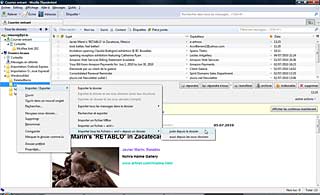Mozilla is a global community of people creating a better Internet. As a wholly owned subsidiary of Mozilla, Mozilla Messaging organizes the development and marketing of email and messaging products encouraging choice, innovation, and opportunity in messaging on the Internet. Thunderbird, as a messaging system, is uniquely positioned as the tool that users can use to integrate as many of their communications as they want.
By combining an open architecture, a powerful extensibility and customization framework, and a person-centric perspective on communications, Thunderbird is a powerful yet enjoyable tool to help individuals manage their online interactions, whether that’s email, instant messaging, social networking messages, or other types of message.
Today, I installed version 3.1 of Thunderbird on my PC running Vista.
The profiles are saved to C:/Users/username/AppData/Roaming/Thunderbird/..
To import the messages from my Windows Mail Client, I installed the ImportExportTools from Kosmos Website. This is done with the menu Tools >> AddOns in the Thunderbird Client. I added a folder “WindowsMail” under “Local Folders” with three subfolders Inbox, SentItems and DeletedItems. After installing the ImportExportTools, a new Menu Import/Export appears when right clicking on a folder tab. All .eml files in the Windows Mail Folder are imported, even with the option of including subfolders.
The Windows Mail messages are located at C:/Users/username/AppData/Local/Microsoft/Windows Mail/Local Folders/…
Finally I installed the freeware MozBackUp 1.4.10 to MozBackup, a simple utility for creating backups of Mozilla Firefox, Mozilla Thunderbird, Mozilla Sunbird, Flock, SeaMonkey, Mozilla Suite, Spicebird, Songbird and Netscape profiles. It allows you to backup and restore bookmarks, mail, contacts, history, extensions, passwords, cache etc.
I configured the Thunderbird Client to use IMAP (Internet Message Access Protocol ) for incoming messages. The current version, IMAP 4 revision 1 (IMAP4rev1), is defined by RFC 3501. IMAP supports both on-line and off-line modes of operation. E-mail clients using IMAP generally leave messages on the server until the user explicitly deletes them. This and other characteristics of IMAP operation allow multiple clients to manage the same mailbox.

